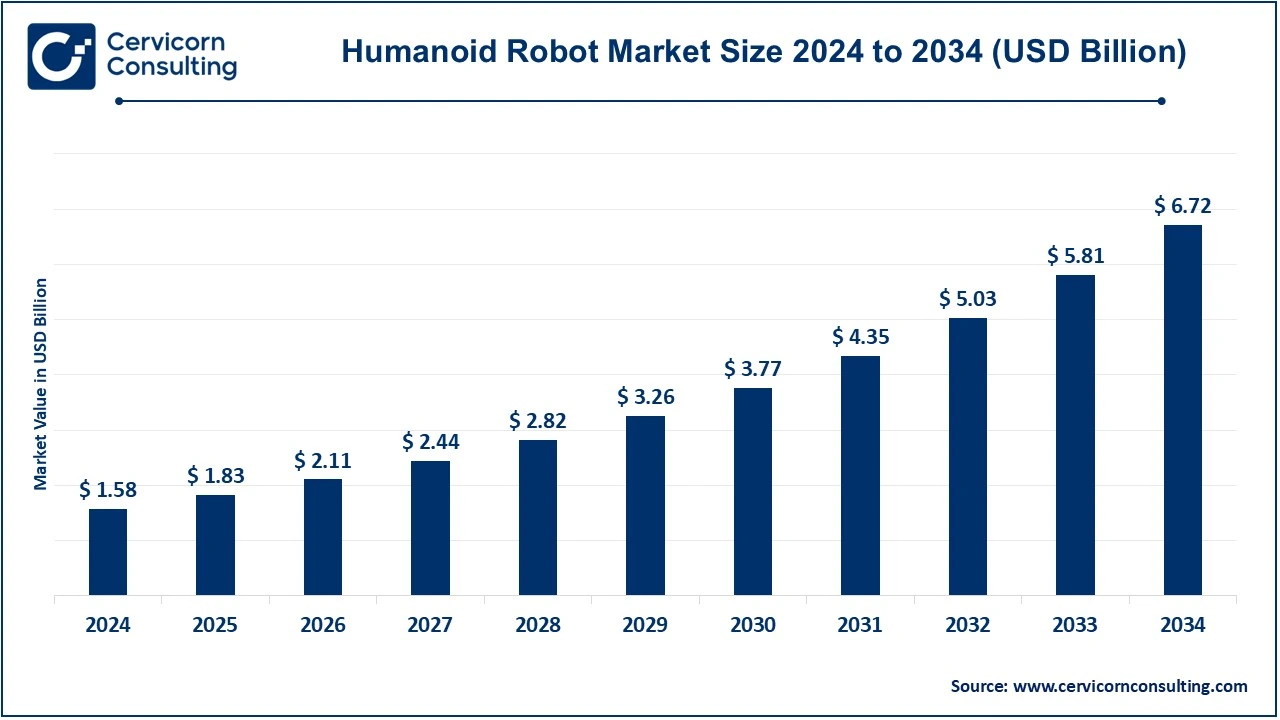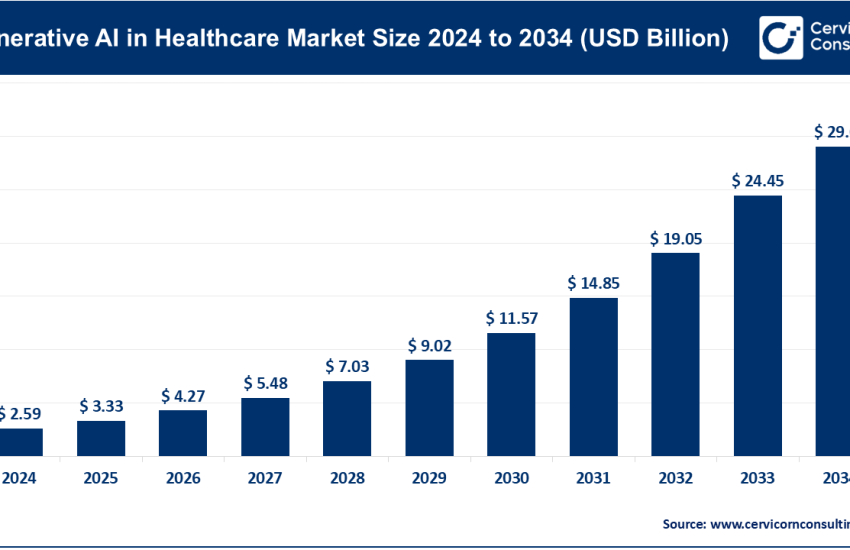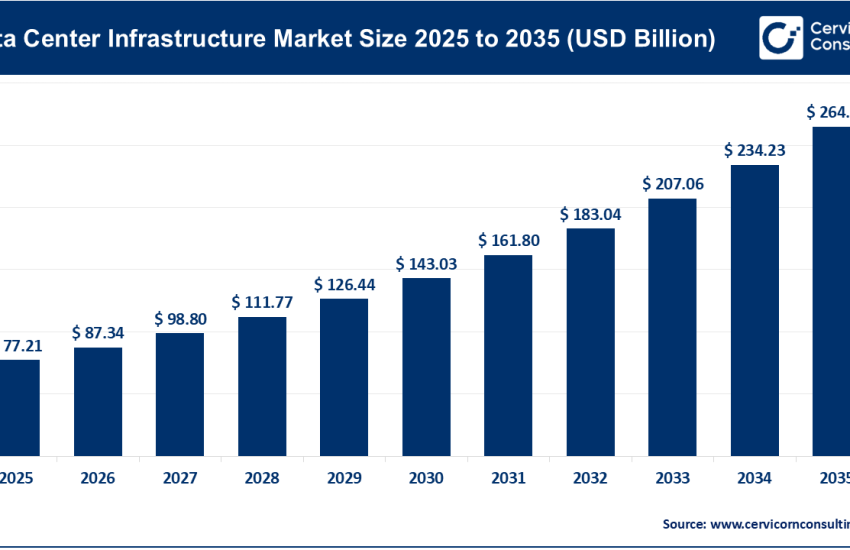Humanoid Robot Market Growth Drivers, Trends, Key Players and Regional Insights by 2034
Humanoid Robot Market Size
The global humanoid robot market size was worth USD 1.58 billion in 2024 and is anticipated to expand to around USD 6.72 billion by 2034, registering a compound annual growth rate (CAGR) of 15.57% from 2025 to 2034.
What Is the Humanoid Robot Market?
The humanoid robot market focuses on the design, development, manufacturing, and application of robots that replicate human form and motion. These robots typically feature two legs, two arms, a torso, and a head, allowing them to operate effectively in environments designed for humans. Unlike industrial robots built for repetitive, pre-programmed tasks, humanoid robots are designed for mobility, adaptability, and social interaction. They combine hardware (motors, sensors, actuators) with sophisticated software (AI, perception, motion planning, and voice recognition) to perform tasks such as assistance, reception, caregiving, and research.
In 2024, the humanoid robot market was valued in the low-billion-dollar range globally, with analysts projecting exponential growth over the next decade. The market includes segments such as bipedal humanoids, wheeled humanoids, and partially anthropomorphic robots. The technology serves industries from hospitality and education to eldercare and industrial assistance, reflecting a broader shift toward flexible, human-centered automation.
Get a Free Sample: https://www.cervicornconsulting.com/sample/2505
Why Is the Humanoid Robot Market Important?
- Adaptability to Human Environments:
Humanoid robots can navigate and operate in spaces designed for people — homes, hospitals, and offices — without the need for major structural changes. - Addressing Labor Shortages:
Many developed countries face labor shortages in healthcare, logistics, and customer service. Humanoids offer a scalable solution by performing repetitive or physically demanding tasks safely and efficiently. - Enhancing Human-Robot Collaboration:
These robots act as partners rather than replacements, assisting humans in collaborative tasks such as manufacturing, rehabilitation, and education. - Innovation Catalyst:
Research in humanoid robotics accelerates advances in AI, control systems, materials science, and human-machine interfaces, benefiting the broader robotics and automation ecosystem. - Strategic Technology Development:
Nations view humanoid robotics as a symbol of technological leadership, encouraging investments and public-private partnerships to maintain global competitiveness.
Top Companies in the Humanoid Robot Market
Below are five major players shaping the humanoid robot market through innovation, specialization, and technological leadership.
1. Engineered Arts Limited
- Specialization:
Engineered Arts is a UK-based robotics company renowned for lifelike humanoid robots designed for entertainment, education, and research. - Key Focus Areas:
The company develops expressive humanoid robots with realistic facial movements, speech synchronization, and advanced human-robot interaction. - Notable Features:
Their flagship models — such as “Ameca” — are known for fluid motion, high-fidelity facial expressions, and responsive AI integration. Engineered Arts focuses on modular architecture, making maintenance and upgrades easy. - 2024 Revenue & Market Share:
Estimated annual revenue in 2024 was around USD 10–12 million, reflecting growing demand from museums, exhibitions, and research institutions. The company holds a small but influential share in the social humanoid segment. - Global Presence:
Engineered Arts has installations and collaborations across Europe, North America, and Asia, making it one of the most recognizable names in lifelike robotic design.
2. HANSON ROBOTICS LTD
- Specialization:
Based in Hong Kong, Hanson Robotics specializes in creating highly expressive social humanoid robots capable of engaging in realistic human-like conversations. - Key Focus Areas:
The company emphasizes social interaction, education, and entertainment applications. It integrates AI, speech recognition, and facial animation to create emotionally engaging robots. - Notable Features:
Hanson’s “Sophia” robot gained worldwide fame for its human-like face, natural conversation, and ability to express emotions. - 2024 Revenue & Market Share:
Estimated annual revenue in 2024 ranged between USD 5–6 million. Although its market share is modest, Hanson Robotics remains a pioneer in social and research humanoids. - Global Presence:
The company collaborates globally with universities, research labs, and public exhibitions, ensuring a strong global footprint.
3. Honda (Honda Robotics / Honda R&D)
- Specialization:
Honda, a Japanese conglomerate, has long been a leader in robotics innovation, best known for developing ASIMO, one of the world’s most advanced bipedal robots. - Key Focus Areas:
The company focuses on mobility robotics, assistive technology, and AI integration to support elderly care and rehabilitation. - Notable Features:
Honda’s humanoids are known for precise balance, coordination, and autonomous mobility. The company continues to research next-generation humanoids emphasizing safety and human interaction. - 2024 Revenue & Market Share:
While Honda’s overall group revenue exceeded hundreds of billions of dollars, its robotics division remains a strategic R&D arm rather than a standalone profit center. - Global Presence:
Honda Robotics operates globally, with R&D centers in Japan, the U.S., and Europe, contributing to both research and product development across industries.
4. HYULIM Robot Co., Ltd
- Specialization:
HYULIM Robot is a South Korean company focused on industrial, service, and humanoid robots. - Key Focus Areas:
The company develops automation systems for manufacturing, logistics, and education, integrating humanoid designs for human-facing tasks. - Notable Features:
HYULIM is known for combining humanoid form factors with industrial functionality, enabling robots to perform both collaborative and standalone tasks. - 2024 Revenue & Market Share:
Public filings show total company revenues in the tens of millions of USD in 2024. Humanoid robots represent a growing share of its product portfolio, supported by domestic demand and government partnerships. - Global Presence:
HYULIM’s presence extends across South Korea and neighboring Asian markets, supported by active government initiatives promoting robotics adoption.
5. KAWADA Robotics Corporation
- Specialization:
KAWADA Robotics, part of Japan’s Kawada Group, focuses on industrial and humanoid research robots. It has been instrumental in developing HRP (Humanoid Robotics Project) platforms in collaboration with Japanese research institutes. - Key Focus Areas:
The company aims to integrate humanoid systems into industrial and service environments, emphasizing safety, reliability, and co-working capability. - Notable Features:
KAWADA’s robots are known for stable walking, dynamic motion, and precision manipulation, making them ideal for human-robot collaboration research. - 2024 Revenue & Market Share:
Group revenues were in the multi-billion-yen range in 2024. Humanoid robotics remains a smaller, innovation-driven part of its portfolio, though its technological contributions have global influence. - Global Presence:
KAWADA collaborates with research organizations worldwide and provides robots for educational and industrial applications across Asia and Europe.
Leading Trends and Their Impact
- AI and Embodied Learning:
Machine learning algorithms now allow humanoid robots to learn movement and decision-making from simulations before real-world deployment. This approach shortens training cycles and reduces hardware wear. - Modular Robotics Architecture:
Manufacturers are adopting modular systems, allowing interchangeable components like arms, legs, and sensors to adapt robots for different applications without complete redesigns. - Human-Safe Actuation and Tactile Feedback:
Innovations in soft robotics, compliant joints, and tactile sensors are making humanoid robots safer for close interaction with humans. - Cloud Robotics Integration:
Many humanoids rely on cloud-based computing for heavy AI tasks while performing local control operations, allowing continuous software updates and shared learning among fleets. - Standardization and Regulation:
Governments and international organizations are developing safety and ethics standards for humanoid deployment, making certification and public use more reliable. - Public and Private Investment:
Countries such as Japan, South Korea, and China are heavily funding humanoid R&D. Meanwhile, Western startups are attracting significant venture capital, leading to faster commercialization.
Successful Examples of Humanoid Robots Worldwide
- Sophia by Hanson Robotics:
Sophia remains one of the most recognized humanoid robots globally, demonstrating natural facial expressions, conversation, and public interaction. - Ameca by Engineered Arts:
Ameca serves as an interactive platform in museums and research institutions, showcasing expressive human-robot communication and responsive dialogue systems. - ASIMO by Honda:
Though retired from active development, ASIMO set milestones in humanoid locomotion, balance, and interaction, influencing new generations of robots. - T-HR3 by Toyota:
A telepresence humanoid controlled by a human operator, enabling precise remote manipulation and applications in hazardous environments. - KAWADA’s HRP Series:
Widely used in academic research, the HRP platforms support robotics experiments and industrial R&D, advancing global humanoid engineering. - HYULIM’s Service Humanoids:
Deployed in South Korean malls and airports, HYULIM robots assist with customer guidance and interactive services, showing real commercial use in public environments.
Global Regional Analysis and Government Policies
Asia-Pacific
The Asia-Pacific region dominates humanoid robotics development due to strong manufacturing bases, government funding, and cultural acceptance of automation.
- Japan:
Japan has pioneered humanoid research through companies like Honda, Toyota, and KAWADA. The government promotes robotics through national strategies that address labor shortages and aging demographics. Programs such as the “Robot Revolution Initiative” fund R&D and encourage integration in healthcare and manufacturing. - South Korea:
The South Korean government supports humanoid robotics via the “Intelligent Robot Basic Plan (2024–2028).” Substantial investments promote robotics education, startups, and pilot deployments in factories and public spaces. - China:
China’s government actively backs humanoid development through subsidies, research centers, and AI-robotics integration initiatives. The nation’s scale in manufacturing provides cost advantages for producing humanoid components and entire systems at lower prices.
North America
The United States leads in AI and hardware innovation for humanoids, supported by a robust startup ecosystem and venture capital. Agencies like DARPA and NSF fund projects that push boundaries in dexterity, mobility, and autonomous learning. Companies are developing humanoids for logistics, defense, and research applications. Canada also supports robotics R&D through grants and academic programs focusing on AI integration and ethics.
Europe
Europe emphasizes ethical and safety standards in robotics. The European Union’s Horizon programs invest heavily in humanoid R&D for eldercare, education, and industrial collaboration. Countries such as Germany, France, and the U.K. focus on standardization, ensuring safe deployment in public and work environments.
Middle East and Rest of the World
The Middle East has begun adopting humanoid robots in retail and tourism. For instance, Dubai and Saudi Arabia have deployed service humanoids in malls and airports to enhance customer experience. In other emerging markets, interest is growing in educational and healthcare applications, often through partnerships with Asian or European manufacturers.
Government Initiatives Shaping the Market
- Funding and R&D Incentives:
Many governments offer tax breaks, subsidies, and direct funding for robotics startups and research institutions to accelerate innovation. - Standardization Frameworks:
International standards for safety, ethics, and interoperability are under development to ensure responsible humanoid deployment. - Education and Workforce Programs:
Training initiatives aim to prepare the workforce for collaboration with humanoid robots, easing the integration into existing labor markets. - Public-Private Partnerships:
Collaborations between government agencies, universities, and private companies are promoting pilot programs for humanoid use in hospitals, transportation, and public services. - Procurement and Demonstration Projects:
National and municipal governments are purchasing humanoid robots for research, exhibitions, and service applications to showcase innovation and gather operational data.
Market Outlook and Regional Dynamics
While exact numbers vary, the humanoid robot market was valued around USD 1.5–2.5 billion in 2024 and is expected to grow significantly through 2034. Asia-Pacific leads in production and deployment, while North America and Europe drive technological innovation and ethical frameworks. Increasing AI integration, government incentives, and cross-industry applications are expected to push the market toward rapid adoption.
Public perception of humanoid robots is improving as people experience their usefulness in real-world scenarios such as healthcare assistance, hospitality, and education. As technology continues to evolve, humanoid robots are poised to become a standard feature of human environments worldwide.
To Get Detailed Overview, Contact Us: https://www.cervicornconsulting.com/contact-us
Read Report: Infusion Pump Market Revenue, Global Presence, and Strategic Insights by 2034



